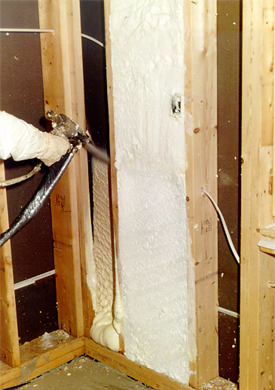 We need greener ways to stop hurting mother Nature. Important part of it is energy conservation with much more intuitive ways.
We need greener ways to stop hurting mother Nature. Important part of it is energy conservation with much more intuitive ways.
Rule of the Thumb: Don’t spend energy to heat and cool the outdoors! Air leakage and improperly installed insulation can waste 20 percent or more of the energy you pay to heat and cool your home. Typical homes have so many leaks, it’s like having a window open all the time, winter and summer.
Leaky Home: Most Homes are not-built while taking into consideration the energy-leakage. As a result, heat/energy leaks out from holes, window borders, pipes and what not.

In this photo, the yellow shows excessive heat loss in winter because the house was not built with the comprehensive air barriers and proper insulation details found in ENERGY STAR homes.
Well-sealed and properly insulated walls, ceiling, and floors help maintain even temperatures throughout the house and save you up to 20-25% on heating and cooling costs. A tighter home also reduces the amount of humidity, dust, pollen, pests, and noise that can come inside, as well as prevent any slow-destructions in your walls, vents.

Wires in Wall: Holes for wiring are sealed with expanding foam.

A Person Caulking: Caulking is an air sealing solution.

An Insulated Wall: All insulation works when
it is installed properly and has no gaps, voids, or compressed areas.

Installing Insulation: A contractor is blowing in foam insulation.

An Insulated Wall: All insulation works when
it is installed properly and has no gaps, voids, or compressed areas.

A SIP Wall: Structural Insulated Panels (SIPs) provide both insulation and an air barrier in one assembly.
With new and more rigorous EPA guidelines to earn the label, ENERGY STAR qualified homes are quieter and more comfortable than ever, have lower utility bills, and help protect the environment by reducing greenhouse gas emissions. Look for a home with the ENERGY STAR, the government-backed symbol for superior energy efficiency.
loading...
loading...

Insulation must be properly structured in a house to save energy and money. I like the recommendations that you gave in improving house insulation. Covering leaks and holes is a good measure to tighten the gaps. Also, using proper insulation materials helps in making the house energy efficient.
We actually considered insulation when we renovated our house last year through the help of insulation contractors (ma). We carefully considered the materials that will be used. We chose foil radiant barrier (ma) insulation since its eco-friendly and it can help us in saving energy. So far, it was successful in cutting down rates and maintaining a comfortable temperature in the house.
loading...
loading...
Seal your home by making sure that there is no bare or open space where air can leak out. This will help insulate your house and prevent heat loss even in just small amount.
loading...
loading...
Insulating your walls will have only a limited effect if you do not also take steps to improve energy efficiency around windows. Glass is simply not a very good insulator, so you can consider adding a layer of glazing or replacing with double-glazed windows.
loading...
loading...
Insulation assists greatly in keeping heat within the house in winter and slowing the flow of heat into the house in summer, creating a comfortable environment all year round. It is also an excellent sound absorber and can assist in reducing noise transmission through walls, ceilings and floors making the home or work environment quieter.
loading...
loading...
You have a great
website here, thanks for sharing.
loading...
loading...
I think it’s much more convenient to install SIPs in your home rather than installing foam insulation between your walls. SIPs are more durable, and easier to install than foam insulation which may take longer, and may be messier to install, and therefore, more expensive. Plus, SIPs are designed to withstand extreme weather conditions, and it’s more aesthetically pleasing to the eye.
loading...
loading...